
The ultimate guide to knowledge management in the age of AI
AI is revolutionizing the customer service industry. Our Customer Service Trends Report 2024 revealed that almost half of customer support teams are currently using AI, with more set to join them this year.
The benefits of AI-first Customer Service are incredible: 24/7 availability, multilingual support, major time savings, and fast, efficient resolutions for customers. But behind every great AI-driven support experience, there’s an unsung hero: knowledge management.
A comprehensive, well-structured knowledge management system is the power source of the AI machine. Whether you’re using a chatbot or AI agent to interact with customers, or an AI copilot as a personal assistant for your support team, these tools need an extensive pool of knowledge to draw from so your customers get accurate, up-to-date information – and your support reps don’t have to answer the same questions over and over.
In this guide, we walk through everything you need to know about effective, AI-optimized customer service knowledge management to help your team take advantage of all the benefits AI has to offer.
What is knowledge management and why is it so important?
Definition: Knowledge management is the process of creating, organizing, sharing, and maintaining knowledge in your business.
Your customer-facing knowledge base is a classic example, but your help center articles are just the tip of the knowledge management iceberg. In fact, knowledge management involves a range of activities such as:
- Creating resources like help center articles, blog posts, internal guides, or learning materials.
- Identifying gaps in your documented information.
- Implementing systems that make it easy for team members (both humans and AI) to access and use this information when solving customer problems.
- Developing workflows to ensure that your existing materials are continuously updated.
Why is knowledge management more important than ever in the age of AI?
Your knowledge base is no longer only for those intrepid customers who want to trek to your help center to self-serve – in the age of AI, it fuels everything.
That’s because your knowledge base is a crucial input for your AI-driven support experience – it’s the key to accurately answering complex customer queries, speeding up resolution and handling times, and delighting your customers.
Here are three reasons why knowledge management is on every forward-thinking support leader’s mind right now.
1. AI is only as strong as what you “feed” it
AI is only as good as the knowledge and content that it has access to. A lack of information, badly structured articles, or out-of-date documentation all prevent it from providing clear and correct answers to your customers, leading to poor customer experiences that degrade trust and fall short of their high expectations.
No large language model (LLM) knows your business like you do. ChatGPT doesn’t understand your customers’ needs, pain points, and use cases. That knowledge is unique to you and your organization, meaning you need to be the one to map it all out and feed it to AI.

2. Every investment of knowledge has compounding results
Making the switch to AI isn’t just adopting a new tool – it means adapting to a new ecosystem. And the sooner you start planting the seeds, the sooner you can start harvesting the rewards.
In less horticultural terms, every upfront investment you make in your knowledge base has long-term benefits. And whether you hire someone to do this work full time or give your agents time away from the queues each week, the ROI speaks for itself.
Think of it this way: say it takes 30 minutes to write a new help doc for a commonly asked question. That 30-minute investment results in:
- Hours saved for your support reps, who no longer have to spend time responding to that query because now AI can handle it instead.
- Calculate: Average time to compose a response X frequency of query = time saved for your team.
- Hundreds of satisfied customers who get an instant, accurate response to their question and don’t need to wait around for an available agent.
- Calculate: Number of customers who ask this query X average time to resolution = total time saved for customers.
- Data about your help docs and AI support experience for you to learn from, so you can make them even more effective.
- Monitor: AI involvement rate, resolution rate.
That’s a pretty good ROI for half an hour’s work.

3. Continuous learning leads to continuous improvement
When it comes to anything AI, the best way to learn is by doing.
A robust knowledge management process ensures you’re constantly getting valuable data to iterate on, so you can see what works and what doesn’t. This helps you to identify opportunities and areas for improvement that will have the biggest impact for your customers and your team, so you can train AI to be the best it can be.
But to start gathering this wealth of information and making these data-driven, customer-centric decisions, you need to start. As the old proverb says, “The best time to plant a tree is 20 years ago. The second best time is now.” The sooner you start getting insights about what your customers want and need from your customer service, the sooner you can deliver it.
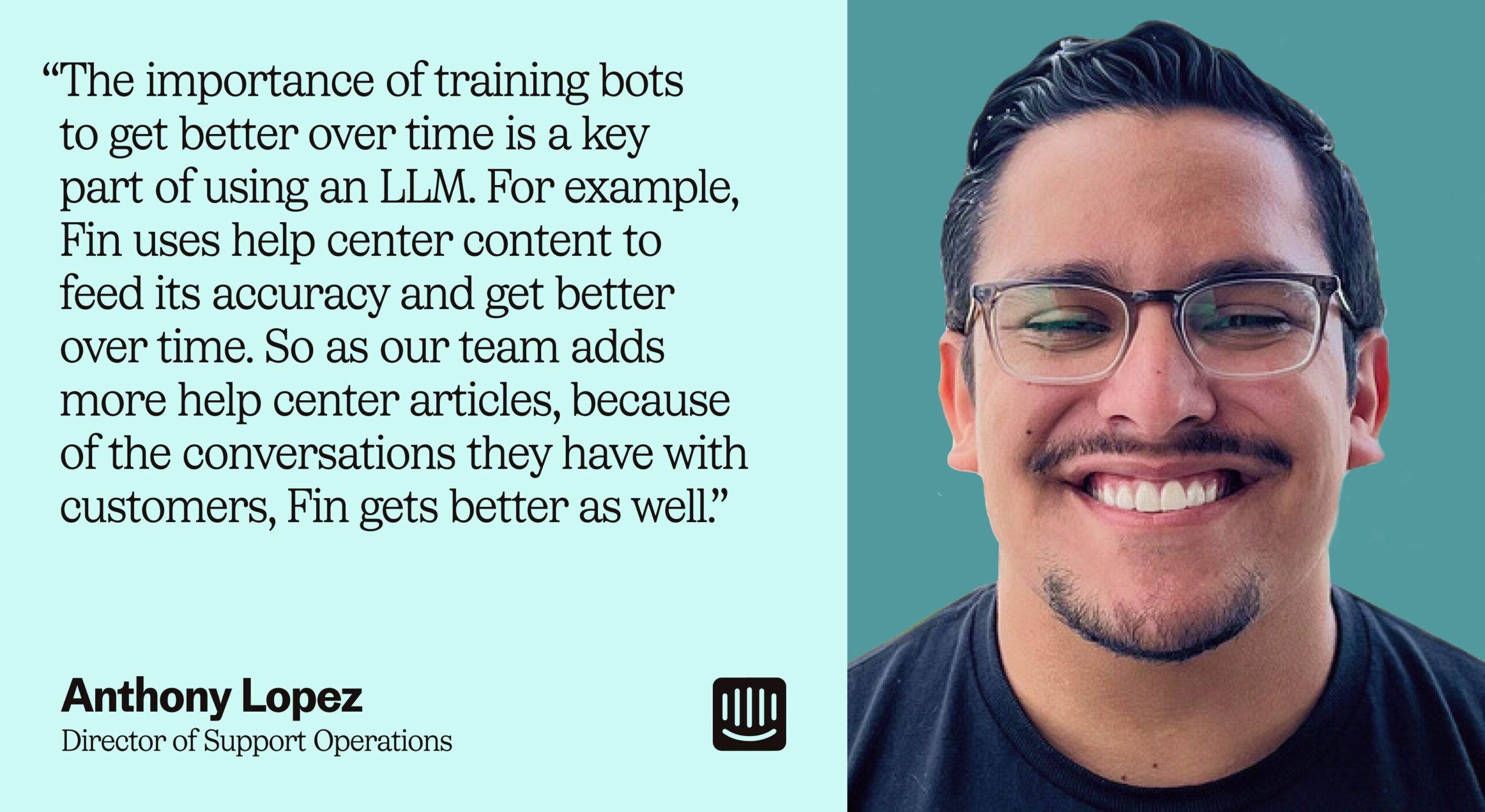
What kind of information should you cover in your knowledge base?
Wrangling and prioritizing all of your internal and external support documentation can feel like a Herculean task, but with the right technology to help you do it, it doesn’t have to. The great thing about using a complete AI-powered platform is that it gives you:
- Data-driven insights to help you identify and prioritize which help content to create based on what customers are actually looking for. For example, with Fin, you get access to an “unresolved questions” report that gives you insight into queries that Fin was unable to resolve and enables you to pinpoint areas where new content is needed.
- A centralized place to create, manage, and optimize your knowledge content. For example, Intercom’s Knowledge Hub enables you to create a single source of truth for your customer-facing and agent-facing help content and enables you to configure and monitor how all of that content is used by AI to help your customers and your team.
Whether you’re just starting out, or are looking for a quick refresher checklist, here are some examples of information to include in your help center to help you get started – as well as multiple ways you can leverage this content to get the most bang for your buck.
1. Troubleshooting and FAQs
- What it is: Troubleshooting and FAQ documents answer common queries or problems that your customers have, like “How do I update my billing information?” or “Why hasn’t my order shipped yet?”
- How to source information: Look for questions that come up again and again in your inbox, as well as topics your customers frequently search for (like “Billing help” or “Order updates”).
- Where to use this content: Knowledge base, AI agent/chatbot, AI copilot, proactive support like tooltips.
2. Quick-start product or feature guides
- What it is: Quick-start guides teach users how to efficiently set up products or features by following a series of sequential steps, such as, “Create your workspace,” “Invite your team,” or “Run your first report.”
- How to source information: Talk to your customer success team or onboarding specialists to learn their recommendations for getting started, or ask your product team to document this process when they’re building new features.
- Where to use this content: Knowledge base, AI agent/chatbot, AI copilot, product tours.
3. Troubleshooting and advanced guides
- What it is: Troubleshooting and advanced guides help users get even more from your product or feature once they’ve mastered the basics, leading to next-level adoption.
- How to source information: Get input from internal experts like product managers, R&D, and customer success managers.
- Where to use this content: Knowledge base, AI agent/chatbot, AI copilot, targeted messaging aimed at advanced users (sent in-app or via email).
4. Best practice tips for specific use cases
- What it is: These are tips aimed at specific cohorts of users who have similar jobs-to-be-done, like engineering teams or startups.
- How to source information: Use a mix of hypothetical examples based on your target audience (your marketing team can help here) and conversations with real customers about their goals and workflows.
- Where to use this content: Knowledge base, AI agent/chatbot, AI copilot, tailored webinars, learning courses.
Create a knowledge management process that fuels your AI with these 5 steps
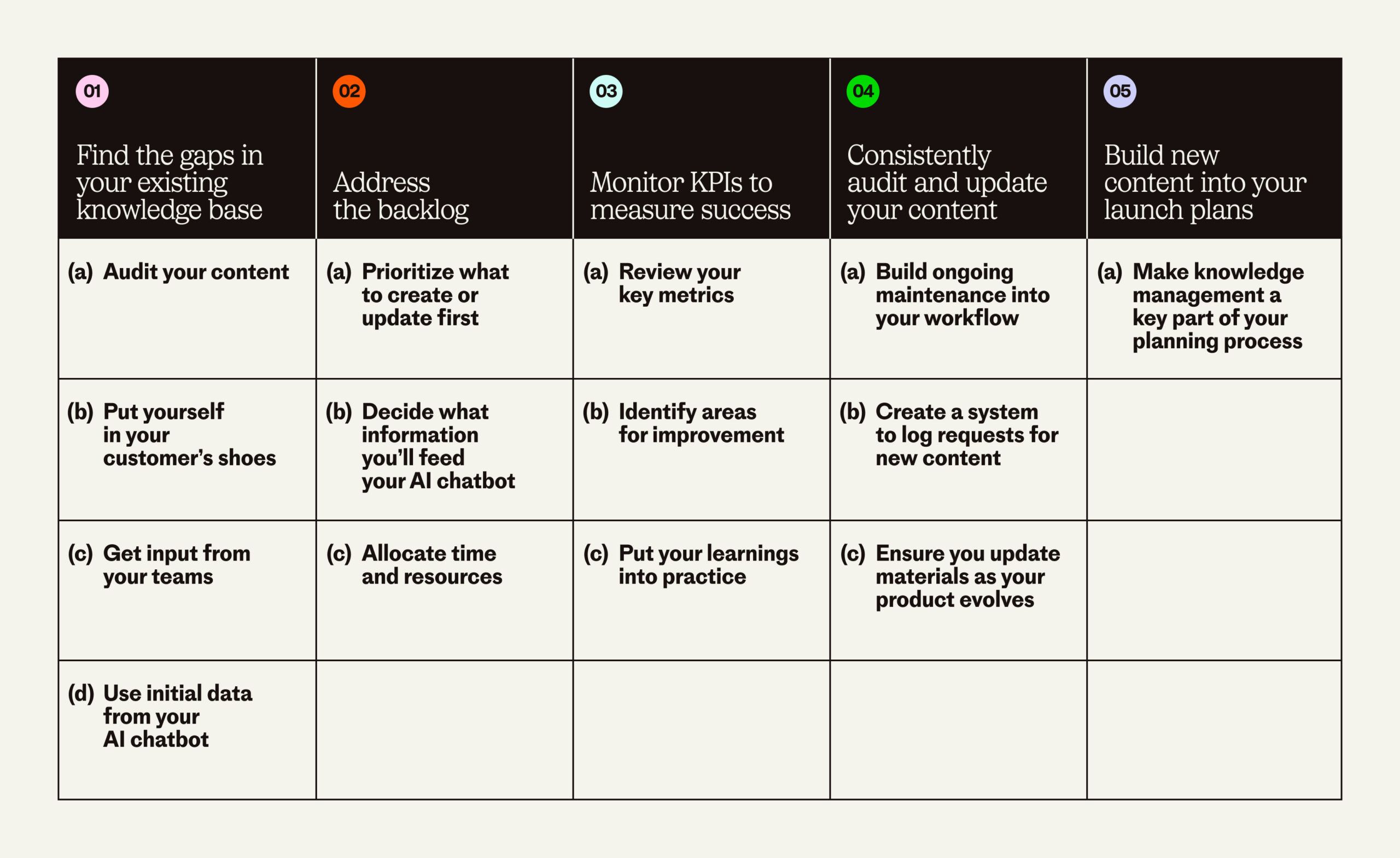
1. Find the gaps in your existing knowledge base
Do an audit of your existing content
The first thing to do is review what materials you currently have. This is for two reasons: firstly, you need to make sure that the AI isn’t learning from out-of-date information, and secondly, it identifies where the current gaps are.
At Intercom, we had over 700 live articles to audit before feeding them to our AI agent, Fin. To do this, we divided the articles into product areas and gave relevant teams a week to check, update, or retire each article. Sharing the ownership like this made it a real team effort, and broke a mammoth job into achievable tasks.
Put yourself in your customer’s shoes
Walk yourself through the same steps that your customer will take when they look for help, including their first encounter with your AI-driven support experience.
“As part of that first deployment, test it yourself, and make sure that you actually experience the experience that your customer is going to have,” advises Declan Ivory, our VP of Customer Support. This will help you test out the quality of the answers and spot any missing topics or keywords in your content.
Seek input from your teams
When auditing and identifying gaps in our content, we didn’t just rely on our customer support team: we took an “all hands on deck” approach. By including your product and engineering teams in this process, you can get expert advice from the people who know more about your product than anyone else (because they built it!). Your sales, marketing, and customer success teams will also have unique insights about what matters to your customers and what they’re trying to achieve.
Use the initial data from your AI agent or chatbot
After 30 days of using an AI agent or chatbot, you’ll have enough data to see where it’s able to successfully resolve questions versus where it’s getting stuck – and why. Dig into that data to find areas to beef up (i.e. topics that don’t have enough content for AI to handle and get handed over to support reps) or articles that need improvement (i.e. conversations that have poor resolution rates or low customer satisfaction scores).
If you’re managing your AI agent or chatbot and knowledge content in the same platform, you’ll be able to get detailed reporting on how your content is performing at every touchpoint so you can pinpoint exactly where you need to focus your efforts.
⚡ Pro tip: If you’re just getting started, consider testing your AI agent/chatbot with a segment of your customers first to get this initial data. Then, once you’ve addressed any immediate gaps, move on to a wider rollout.
2. Make a plan to address the backlog
Prioritize which content to update or create first
By now you’re probably bursting at the seams with amazing help content ideas from every corner of the company. Next step: deciding where to start.
When you’re prioritizing content, what you’re really trying to do is find out what’s driving volume for your customer support team and identify the easiest wins that will reduce that volume. To help you manage your resources and work on things with the greatest impact, try these tips:
- Look at data and metrics from your conversations to see the most asked questions, which queries have the longest handle time, and which conversation topics have lower customer satisfaction (CSAT) scores, then create or improve content around those topics.
- Prioritize topics based on the value they’ll bring to the business. For example, create documentation for features on higher tier plans before free ones.
- Use reporting to find searches with no results, or filter by “Last updated” to find help articles that haven’t been updated in a while and may need a refresh.
Decide what information you’ll feed the AI
When sourcing knowledge for AI to use, cast a wide net – because you probably have more relevant content than you realize. We quickly learned that almost any and all information is useful once it’s framed the right way, so leverage what you already have.
For example, with Fin AI Agent, you can use:
- Your help center
- Inbox suggestions
- Saved macros
- Snippets
- PDF files
- Website pages
- Your blog
And AI Copilot can also draw from internal documents (like Notion or Guru knowledge bases), as well as past cases and conversations.
Within Intercom, you can manage all of these content sources in Knowledge Hub so you can monitor how Fin uses the content, control which sources it can pull from, and continuously optimize your content to ensure your customers are always getting the most recent and accurate information.
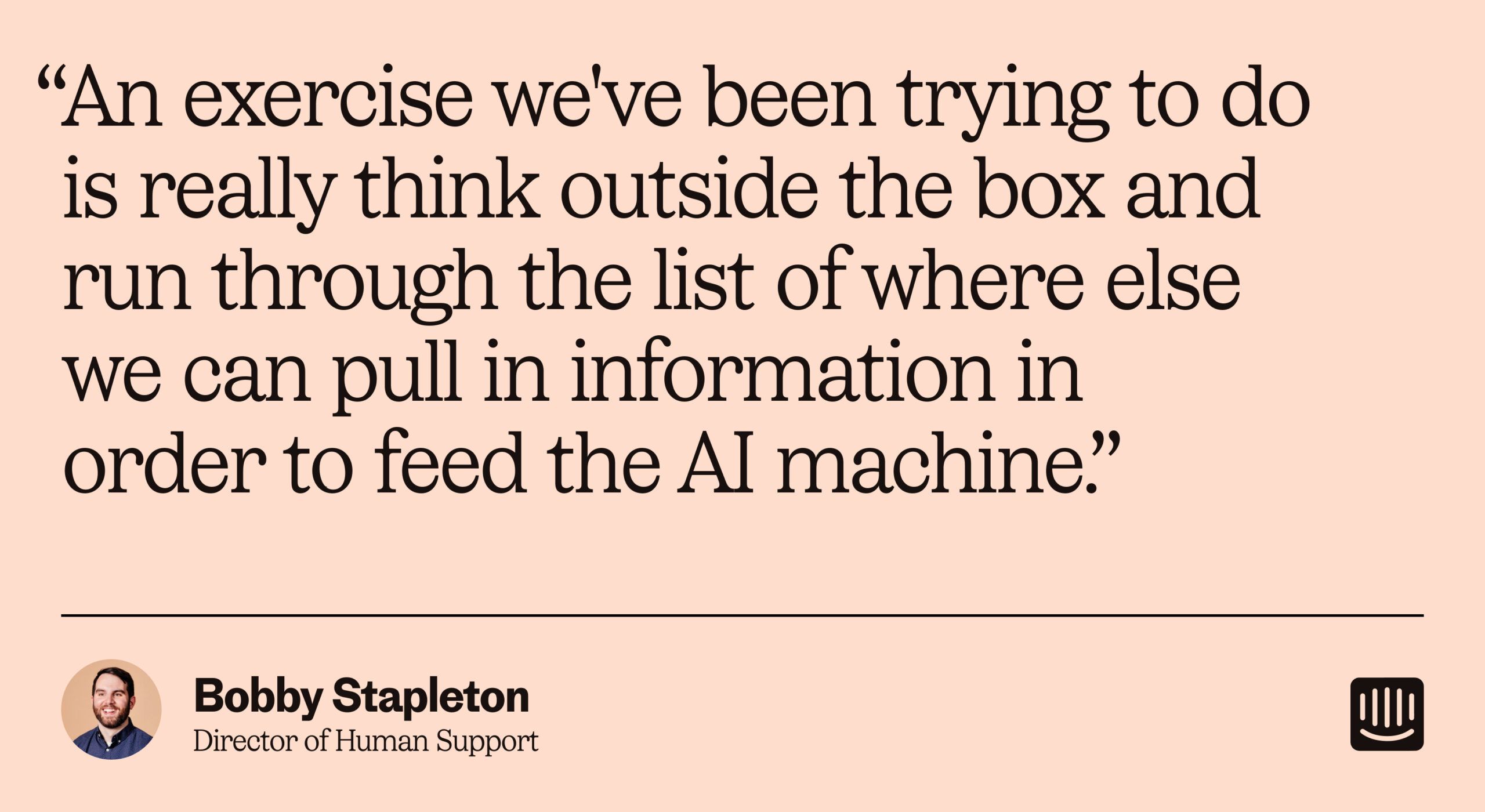
Allocate time and resources
Be intentional about carving out time to work on your help content. “The way we do it at Intercom is that we have something called a ‘Special-T’,” says Anthony. “This is a dedicated team of frontline reps, a mix of our support specialists and engineers who are actually spending time out of the inbox every single week. We typically allocate maybe 5–10 hours per individual contributor,” he shares.
Together, this group works with the knowledge manager (that’s me!) to build out our backlog of content.
⚡ Pro tip: These projects are a great way to help your support reps upskill and develop into the exciting new roles AI is creating in customer service.
3. Monitor KPIs to measure success
Review key performance indicators
Once you’ve started using AI, track KPIs and business metrics to measure the impact it’s having. Some relevant KPIs to watch out for include:
- Customer satisfaction (CSAT) score, for both bots and humans
- Resolution rate
- Self-serve rate
- Chatbot involvement rate
- First response time
- Number of handovers to human support reps
All of these metrics help you spot which content is performing best – and where you can improve your knowledge management process.
Put your learnings into action
Ideally, you’ll see amazing results straight away (woohoo!), but it’s highly unlikely that you’ll get everything right immediately. There’ll be some problems AI can’t solve yet, some workflows that need adapting, and some users that didn’t get the answer they wanted but never followed up to let you know (resulting in a “false positive” resolution).
All of this is good, because it gives you real data about what your customers need and value to achieve “true” resolutions. The most useful insights and impact will come from these resolutions. Do the work, iterate, and keep monitoring and reporting.
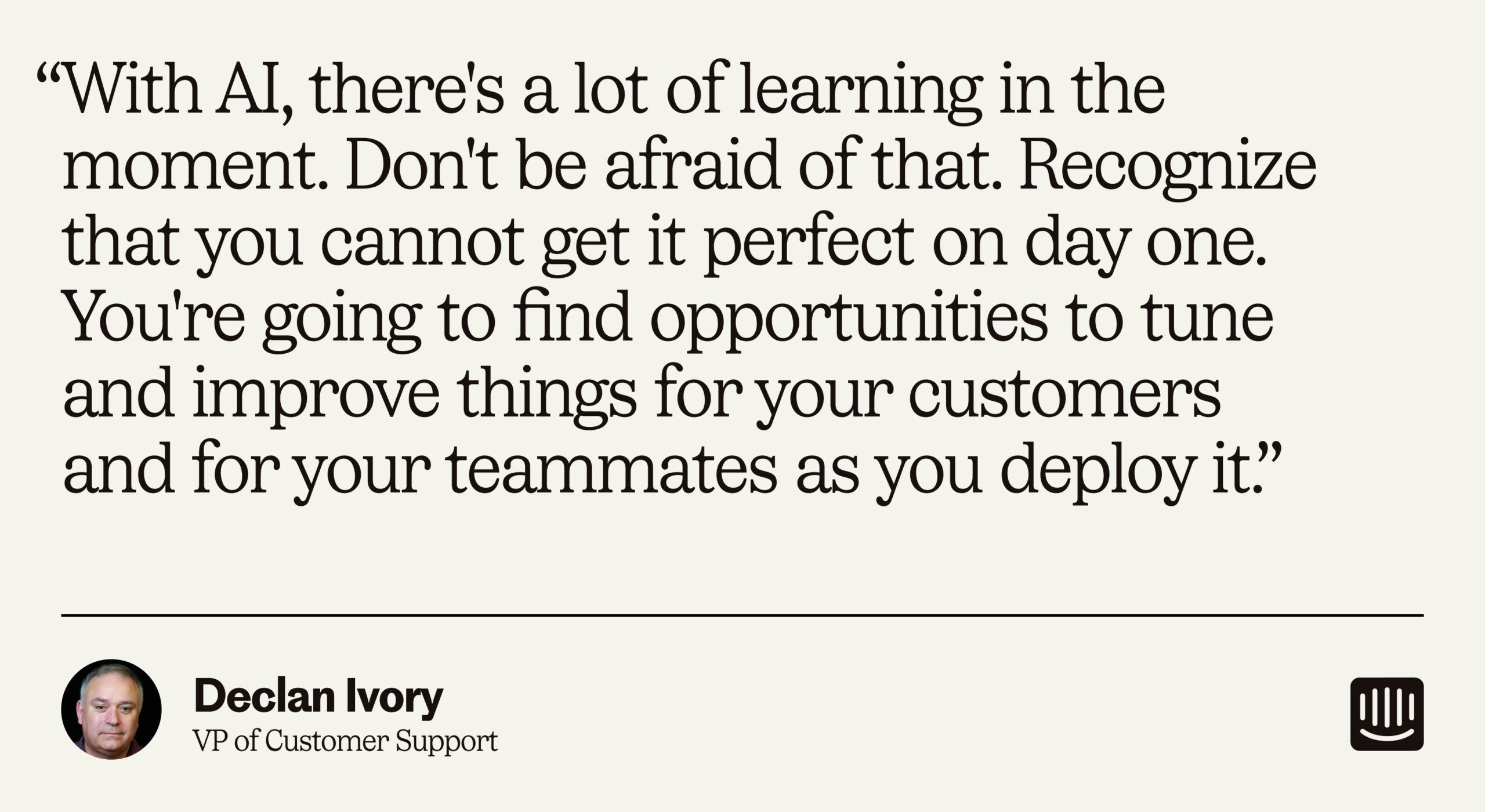
4. Audit, audit, audit
Build ongoing maintenance into your workflow
Knowledge management is a process. It doesn’t end once you’ve published a certain number of help articles.
As your product, customers, and business goals evolve, so too should your help content. This means you need to build maintaining, updating, and creating new content into your team’s workflow on an ongoing basis – not just in the mad rush before a new feature gets launched.
Map out a plan for updating your content that outlines:
- Who is responsible for refreshing or creating new content.
- How often existing content should be reviewed so it doesn’t become stale.
- When they should do this (i.e. for one hour per day, every Friday, monthly, or whatever cadence makes sense for your team).
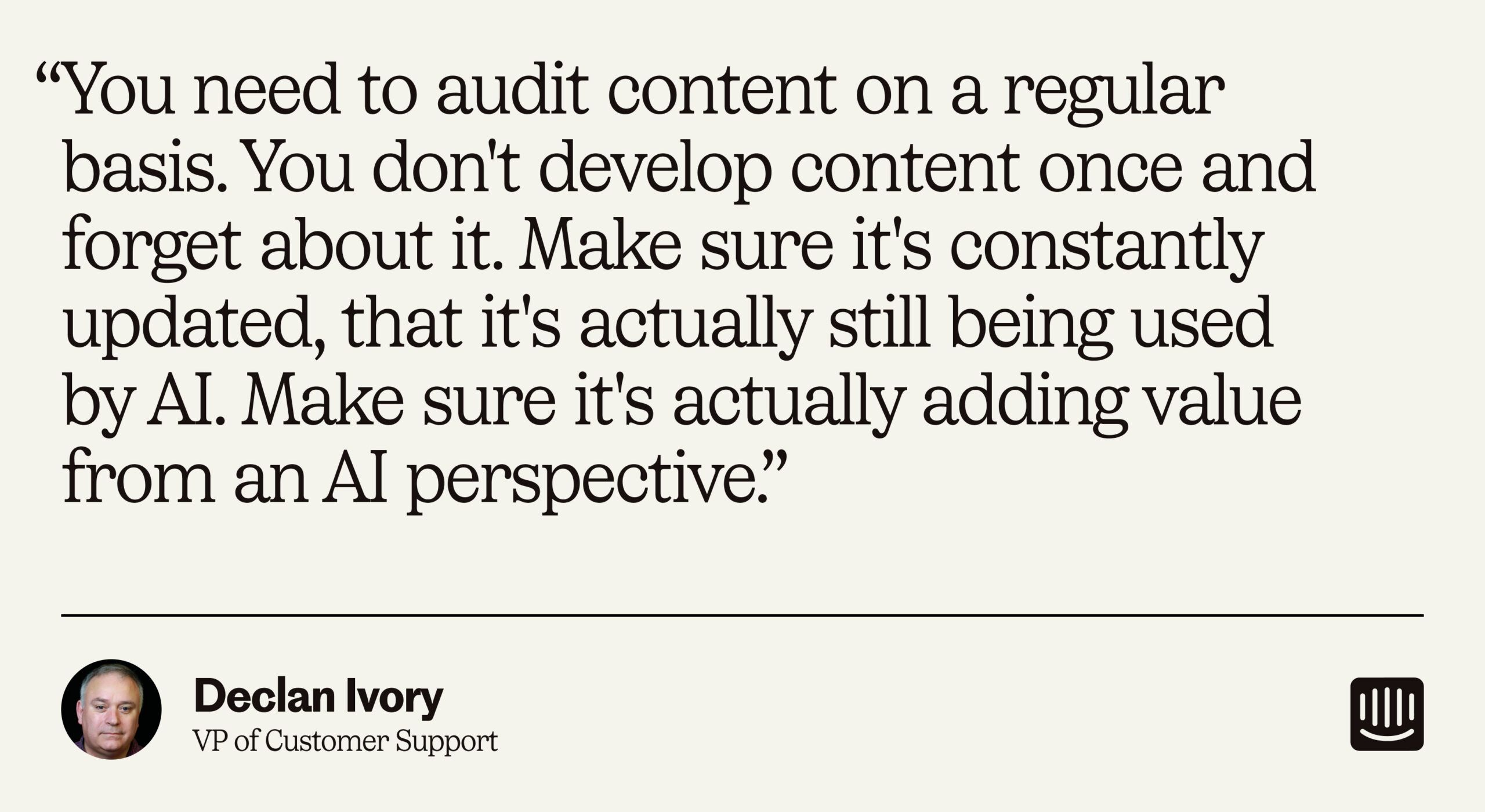
Develop a system to log requests for new content
Encourage the cultural shift to a “knowledge management” mindset by making it easy for everyone to share ideas for new or improved help content. Create a simple system for team members to log content requests, so you can capture insights from all customer-facing and product teams – and address customer needs from every angle.
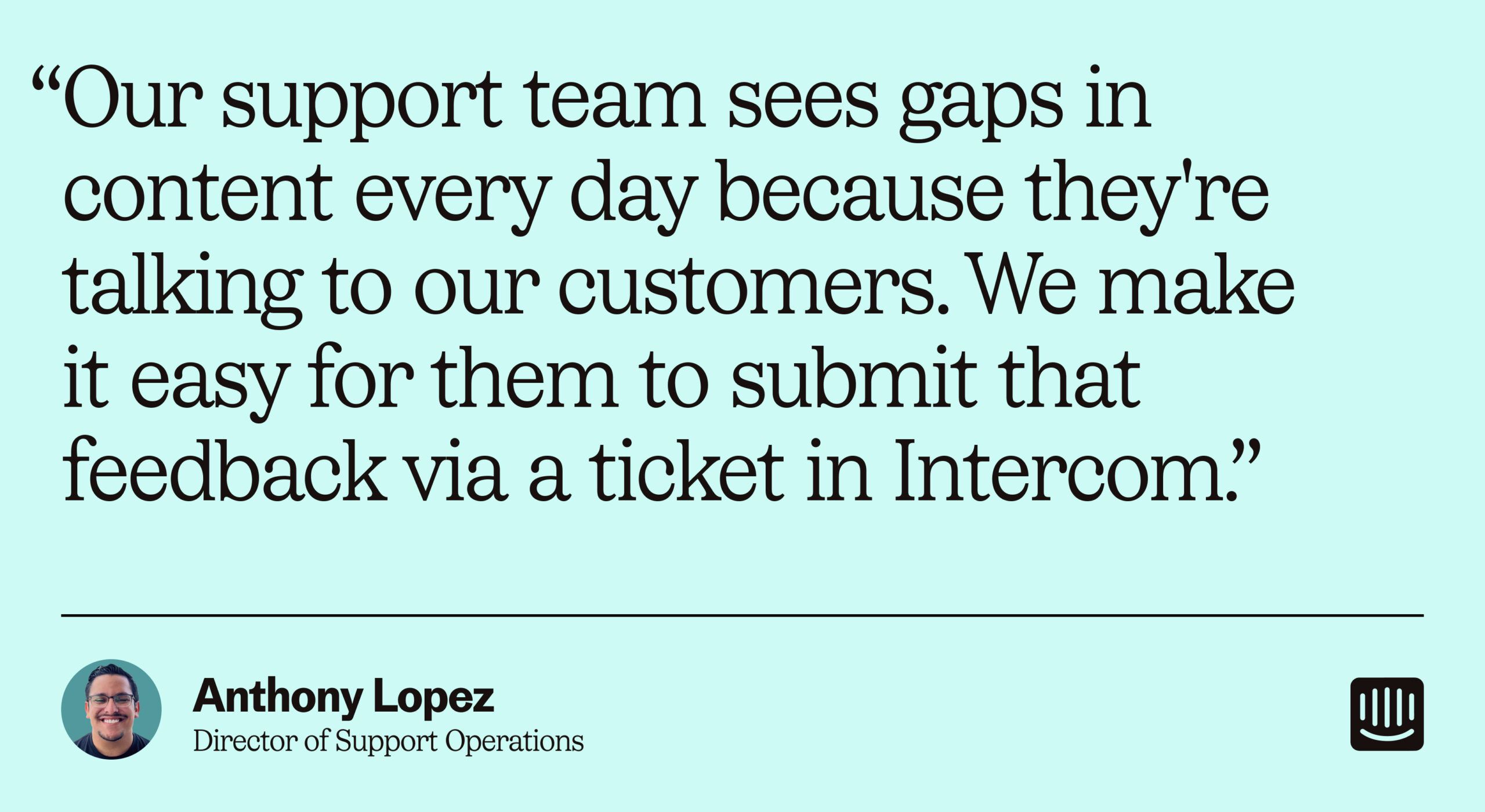
5. Build knowledge management into future launch plans
Make knowledge management an essential part of product development
Depending on your industry, you might be building new features or shipping new products, and creating high-quality help content for them should be an integral part of your launch checklist. Work with your product team, product managers, and product marketing managers to build out your launch content, then review customer conversations after going live to spot opportunities for additional resources.
Best practices for AI-friendly knowledge management in 2024
Use the terms your customers are using
Getting the language right in your help documents is important – and tricky. Language is diverse, and varies by location (“cilantro” versus “coriander”), dialect (“hoagie” versus “sub”), and even different types of users (a marketer might call someone a “lead” while a salesperson might call them a “prospect”). Analyze your search data to discover what words your customers use, and speak their language.
⚡ Pro tip: Introduce AI to different groups of users, like power users and customers on a free trial. This reveals variations in wording when asking the same questions, which you can incorporate as you create materials for different audiences.
Simplify your language and remove ambiguity
Luckily, machine-friendly language also means people-friendly language. Remember that you’re not just writing for AI, but for real people with all different technical abilities and backgrounds. Keep your language as simple as possible: avoid jargon, spell out any acronyms, and explain key terms.
📺 Learn more about avoiding ambiguity in your support content →
Create a consistent, trustworthy, and on-brand experience
Brand consistency is crucial for building customer trust. It ensures that people feel like they’re talking to one company, no matter which customer service channel they use. To achieve this, make sure that product and feature terminology is consistent across every touchpoint, proofread for spelling and grammar, and use the same formats when creating new help docs to keep them cohesive (templates are super helpful here).

Add context to your answers
“If you’ve got an FAQ document today that a human can interpret and you’ve got simple yes or no answers in there, the machine won’t interpret those answers in the same way that a human does,” explains Declan. “You’ve got to expand on what you mean when you say ‘yes,’ what you mean when you say ‘no.’” To do this, we recommend restating the question in your answer; this gives AI extra context and clarity that helps it learn.
📺 Learn more about optimizing your help center answers for AI →
Add text to images and videos
Showing as well as telling is great – but AI can’t parse videos or images, so always include explanatory text alongside them. Not only is this more accessible for AI, but it’s more accessible for your audience, too, ensuring that users with visual or auditory impairments aren’t left out.
Create a scannable structure with formatting
Use headers, bulleted lists, and tables to organize your information and make it easier for AI (and human readers) to quickly find the information they need. H1s, H2s, and H3s are all helpful when used correctly – but don’t have large chunks of information below H4s, as it’s difficult for AI to find information there.
📺 Learn more about using rich formatting in your help content →
Include contact details for customers who need them
Including contact information reassures customers that if AI can’t answer their problem, they’ll still get the support they need. Just make sure to include context for the information you provide so that it’s crystal clear when and how to use them.
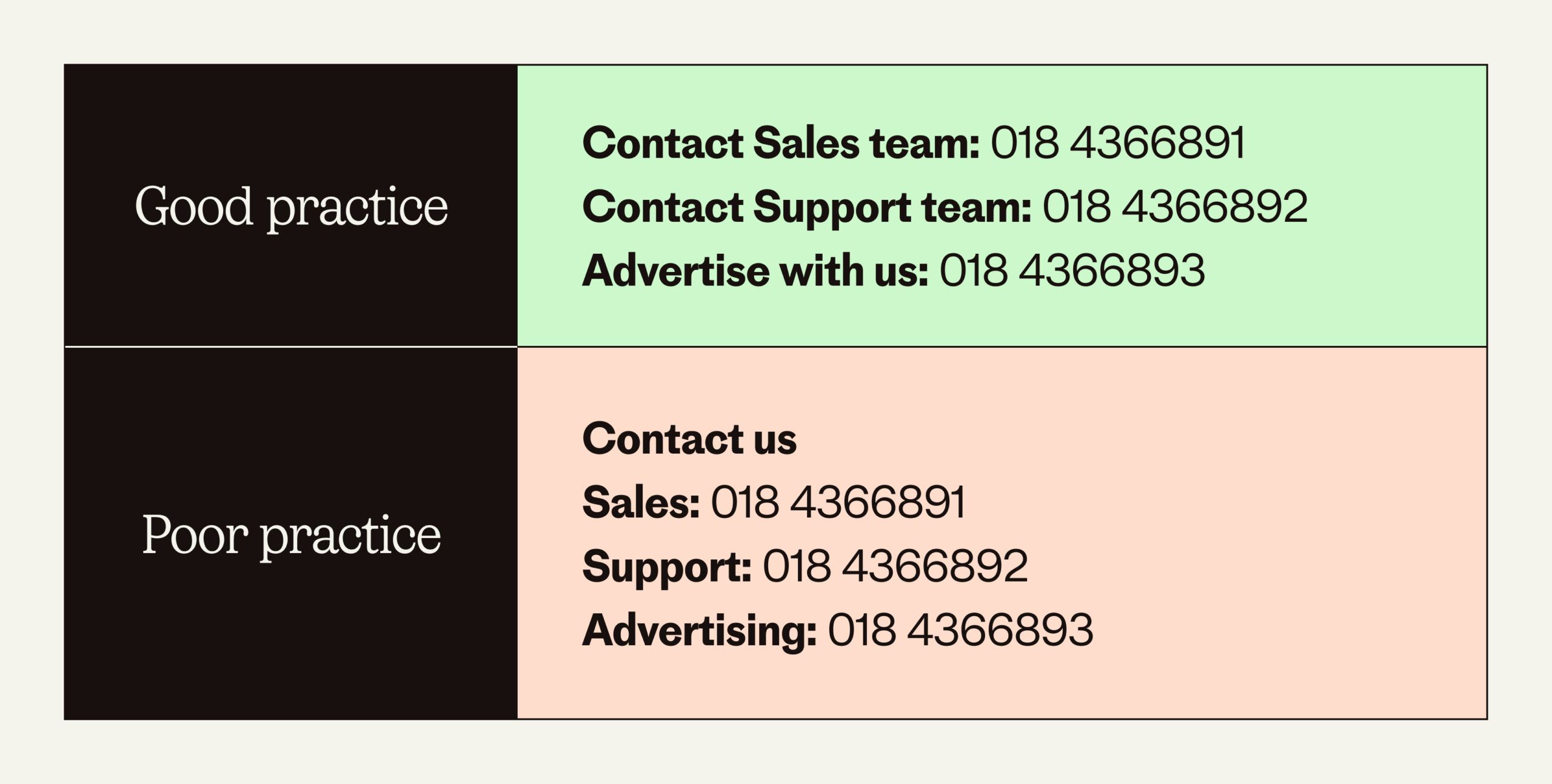
Include context for any contact details so your users know the best channel for their needs
Collect bitesize information in FAQ articles
If you have small pieces of information that don’t need a full article, compile them into a list of FAQs. These can be some of the highest volume, most repetitive questions, so this way, AI will still be able to find the answer.
Clearly identify who the content is aimed at
If you have different help content for different types of users – for example, customers on different price plans who may not have access to all the features mentioned – make sure each piece of help content clearly references who it’s for. You can also use behind-the-scenes audience targeting rules and workflows to help surface the right content for the right users and deliver a more personalized experience.
Use an AI-first customer service solution to get (and action) more data
When you’re using a consolidated AI-first customer service platform, everything becomes part of a powerful cycle. All your customer support data and knowledge content is in one place, making it easier to analyze, monitor, and iterate on the support experience as a whole – simply, quickly, and securely.
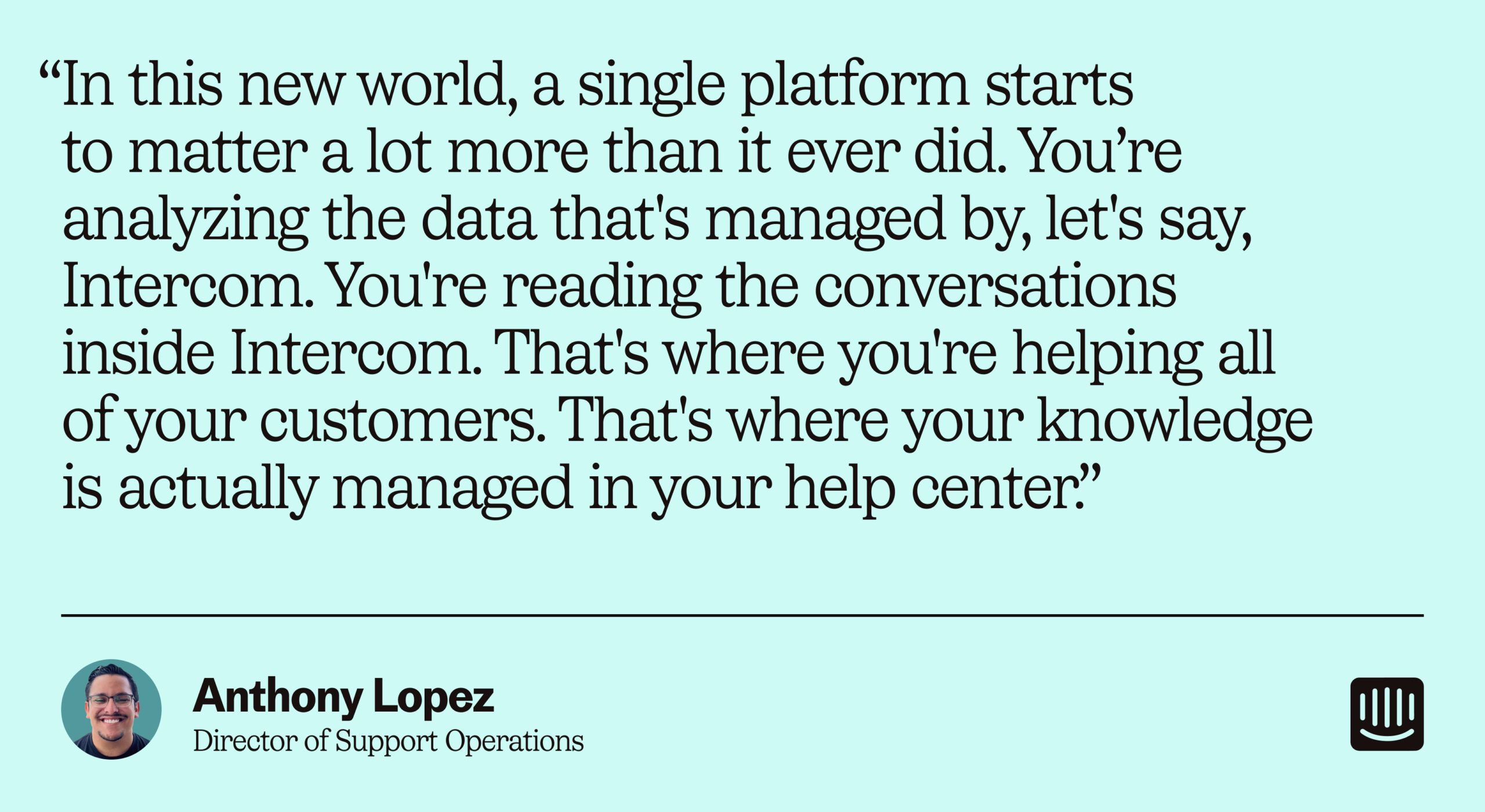
Power up your AI with a future-ready knowledge management process
AI is vital to creating an industry-leading customer experience – and to perform efficiently, it needs to be underpinned by a comprehensive, AI-friendly knowledge management process.
Ready to put these tips into practice? Intercom’s AI-first customer service platform offers cutting-edge AI tools powered by a centalized Knowledge Hub to ensure your customers and support team can always get the answers they need – fast. Get started with a free trial and start turning your help content into resolutions.






